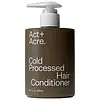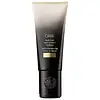What's inside
What's inside
 Key Ingredients
Key Ingredients

 Benefits
Benefits

 Concerns
Concerns

 Ingredients Side-by-side
Ingredients Side-by-side

Water
Skin ConditioningGlycerin
HumectantEthylhexyl Olivate
Skin ConditioningIsostearyl Ethylimidazolinium Ethosulfate
Triethyl Citrate
MaskingAcrylamidopropyltrimonium Chloride/Acrylates Copolymer
Palmitamidopropyltrimonium Chloride
Hydroxypropyl Starch Phosphate
Cetrimonium Chloride
AntimicrobialIsoceteth-20
EmulsifyingIsohexadecane
EmollientMagnesium Aluminum Silicate
AbsorbentSorbitan Oleate
EmulsifyingIsoamyl Laurate
EmollientPropylene Glycol Dibenzoate
Skin ConditioningAdansonia Digitata Seed Oil
EmollientAmaranthus Caudatus Seed Oil
EmollientAmyris Balsamifera Bark Oil
MaskingAquilaria Agallocha Wood Oil
MaskingCananga Odorata Flower Oil
MaskingCaprylic/Capric Triglyceride
MaskingCaprylyl Glycol
EmollientCistus Ladaniferus Leaf/Stem Extract
MaskingCitric Acid
BufferingCoceth-7
EmulsifyingCrambe Abyssinica Seed Oil
Skin ConditioningDimethylheptenal
PerfumingElettaria Cardamomum Seed Oil
MaskingGamma-Nonalactone
MaskingGuar Hydroxypropyltrimonium Chloride
Skin ConditioningHelianthus Annuus Seed Oil
EmollientHexenyl Acetate
MaskingHexylene Glycol
EmulsifyingHydrogenated Castor Oil/Sebacic Acid Copolymer
EmollientHydrolyzed Pea Protein
EmollientHydrolyzed Quinoa
Skin ConditioningHydrolyzed Soy Protein
HumectantIonone
AstringentJuniperus Virginiana Oil
MaskingLavandula Angustifolia Oil
MaskingLinoleic Acid
CleansingLinolenic Acid
CleansingMoringa Oleifera Seed Oil
EmollientPanthenol
Skin ConditioningPassiflora Edulis Seed Oil
EmollientPhenoxyethanol
PreservativePogostemon Cablin Leaf Oil
MaskingPotassium Sorbate
PreservativeRosmarinus Officinalis Leaf Extract
AntimicrobialSodium Hydroxide
BufferingSqualane
EmollientTetrasodium Glutamate Diacetate
Vanillin
MaskingViola Odorata Flower/Leaf Extract
MaskingWater, Glycerin, Ethylhexyl Olivate, Isostearyl Ethylimidazolinium Ethosulfate, Triethyl Citrate, Acrylamidopropyltrimonium Chloride/Acrylates Copolymer, Palmitamidopropyltrimonium Chloride, Hydroxypropyl Starch Phosphate, Cetrimonium Chloride, Isoceteth-20, Isohexadecane, Magnesium Aluminum Silicate, Sorbitan Oleate, Isoamyl Laurate, Propylene Glycol Dibenzoate, Adansonia Digitata Seed Oil, Amaranthus Caudatus Seed Oil, Amyris Balsamifera Bark Oil, Aquilaria Agallocha Wood Oil, Cananga Odorata Flower Oil, Caprylic/Capric Triglyceride, Caprylyl Glycol, Cistus Ladaniferus Leaf/Stem Extract, Citric Acid, Coceth-7, Crambe Abyssinica Seed Oil, Dimethylheptenal, Elettaria Cardamomum Seed Oil, Gamma-Nonalactone, Guar Hydroxypropyltrimonium Chloride, Helianthus Annuus Seed Oil, Hexenyl Acetate, Hexylene Glycol, Hydrogenated Castor Oil/Sebacic Acid Copolymer, Hydrolyzed Pea Protein, Hydrolyzed Quinoa, Hydrolyzed Soy Protein, Ionone, Juniperus Virginiana Oil, Lavandula Angustifolia Oil, Linoleic Acid, Linolenic Acid, Moringa Oleifera Seed Oil, Panthenol, Passiflora Edulis Seed Oil, Phenoxyethanol, Pogostemon Cablin Leaf Oil, Potassium Sorbate, Rosmarinus Officinalis Leaf Extract, Sodium Hydroxide, Squalane, Tetrasodium Glutamate Diacetate, Vanillin, Viola Odorata Flower/Leaf Extract
Water
Skin ConditioningCetearyl Alcohol
EmollientBehentrimonium Chloride
PreservativeDimethicone
EmollientCetyl Alcohol
EmollientStearamidopropyl Dimethylamine
EmulsifyingAmodimethicone
Hydrogenated Ethylhexyl Olivate
EmollientCetyl Esters
EmollientPropanediol
SolventParfum
MaskingPolysorbate 60
EmulsifyingGuar Hydroxypropyltrimonium Chloride
Skin ConditioningButyrospermum Parkii Butter
Skin ConditioningDimethiconol
EmollientHydrogenated Olive Oil Unsaponifiables
EmollientHydroxyethylcellulose
Emulsion StabilisingPanthenol
Skin ConditioningGlycerin
HumectantDisodium EDTA
C11-15 Pareth-7
EmulsifyingLaureth-9
EmulsifyingCetrimonium Chloride
AntimicrobialTrideceth-15
EmulsifyingTrideceth-3
EmulsifyingPentaerythrityl Tetra-Di-T-Butyl Hydroxyhydrocinnamate
AntioxidantBHT
AntioxidantTrideceth-12
EmulsifyingPolysilicone-15
UV FilterJojoba Esters
EmollientQuaternium-95
UV AbsorberAcetic Acid
BufferingAdansonia Digitata Seed Oil
EmollientArgania Spinosa Kernel Oil
EmollientCaffeine
Skin ConditioningButylene Glycol
HumectantMoringa Oleifera Seed Oil
EmollientAlcohol
AntimicrobialCamellia Sinensis Leaf Extract
AntimicrobialChondrus Crispus Extract
Skin ConditioningCitrus Limon Fruit Extract
MaskingJasminum Officinale Flower Extract
MaskingPassiflora Incarnata Extract
AstringentRibes Nigrum Fruit Extract
AstringentCystine Bis-Pg-Propyl Silanetriol
Skin ConditioningHydrolyzed Vegetable Protein Pg-Propyl Silanetriol
Skin ConditioningHydrolyzed Vegetable Protein
Skin ConditioningBromelain
Skin ConditioningCitrus Aurantium Bergamia Leaf Extract
AstringentLeontopodium Alpinum Extract
Skin ConditioningNiacinamide
SmoothingSantalum Album Extract
CleansingAmber Extract
Skin ConditioningCitrullus Lanatus Fruit Extract
Skin ConditioningTocopherol
AntioxidantVegetable Amino Acids
Skin ConditioningCupressus Sempervirens Seed Extract
PerfumingOryza Sativa Seed Protein
AntioxidantLeuconostoc/Radish Root Ferment Filtrate
AntimicrobialPhytic Acid
Oryza Sativa Extract
AbsorbentCitrulline
Skin ConditioningGluconolactone
Skin ConditioningBiotin
AntiseborrhoeicTocopheryl Acetate
AntioxidantLitchi Chinensis Pericarp Extract
Skin ConditioningMoringa Oleifera Seed Extract
Skin ConditioningCalcium Gluconate
HumectantSodium Phosphate
BufferingDisodium Phosphate
BufferingBenzyl Alcohol
PerfumingEthylhexylglycerin
Skin ConditioningPhenoxyethanol
PreservativeCaprylyl Glycol
EmollientIsopropyl Alcohol
SolventPotassium Sorbate
PreservativeChlorphenesin
AntimicrobialSodium Benzoate
MaskingCitric Acid
BufferingLimonene
PerfumingHexyl Cinnamal
PerfumingWater, Cetearyl Alcohol, Behentrimonium Chloride, Dimethicone, Cetyl Alcohol, Stearamidopropyl Dimethylamine, Amodimethicone, Hydrogenated Ethylhexyl Olivate, Cetyl Esters, Propanediol, Parfum, Polysorbate 60, Guar Hydroxypropyltrimonium Chloride, Butyrospermum Parkii Butter, Dimethiconol, Hydrogenated Olive Oil Unsaponifiables, Hydroxyethylcellulose, Panthenol, Glycerin, Disodium EDTA, C11-15 Pareth-7, Laureth-9, Cetrimonium Chloride, Trideceth-15, Trideceth-3, Pentaerythrityl Tetra-Di-T-Butyl Hydroxyhydrocinnamate, BHT, Trideceth-12, Polysilicone-15, Jojoba Esters, Quaternium-95, Acetic Acid, Adansonia Digitata Seed Oil, Argania Spinosa Kernel Oil, Caffeine, Butylene Glycol, Moringa Oleifera Seed Oil, Alcohol, Camellia Sinensis Leaf Extract, Chondrus Crispus Extract, Citrus Limon Fruit Extract, Jasminum Officinale Flower Extract, Passiflora Incarnata Extract, Ribes Nigrum Fruit Extract, Cystine Bis-Pg-Propyl Silanetriol, Hydrolyzed Vegetable Protein Pg-Propyl Silanetriol, Hydrolyzed Vegetable Protein, Bromelain, Citrus Aurantium Bergamia Leaf Extract, Leontopodium Alpinum Extract, Niacinamide, Santalum Album Extract, Amber Extract, Citrullus Lanatus Fruit Extract, Tocopherol, Vegetable Amino Acids, Cupressus Sempervirens Seed Extract, Oryza Sativa Seed Protein, Leuconostoc/Radish Root Ferment Filtrate, Phytic Acid, Oryza Sativa Extract, Citrulline, Gluconolactone, Biotin, Tocopheryl Acetate, Litchi Chinensis Pericarp Extract, Moringa Oleifera Seed Extract, Calcium Gluconate, Sodium Phosphate, Disodium Phosphate, Benzyl Alcohol, Ethylhexylglycerin, Phenoxyethanol, Caprylyl Glycol, Isopropyl Alcohol, Potassium Sorbate, Chlorphenesin, Sodium Benzoate, Citric Acid, Limonene, Hexyl Cinnamal
Alternatives
Ingredients Explained
These ingredients are found in both products.
Ingredients higher up in an ingredient list are typically present in a larger amount.
Baobab seed oil is an emollient. It is rich in fatty acids and vitamins A, E, and D.
The fatty acid content of this oil is roughly 30-40% oleic acid, 24-34% linoleic acid, and 18-30% palmitic acid. This gives it skin hydrating and nourishing properties.
Due to this fatty acid content, this ingredient may not be fungal-acne safe.
Fun fact: Our skin uses fatty acids, and especially linoleic acid, for creating ceramides.
Learn more about Adansonia Digitata Seed OilCaprylyl Glycol is a humectant and emollient, meaning it attracts and preserves moisture.
It is a common ingredient in many products, especially those designed to hydrate skin. The primary benefits are retaining moisture, skin softening, and promoting a healthy skin barrier.
Though Caprylyl Glycol is an alcohol derived from fatty acids, it is not the kind that can dry out skin.
This ingredient is also used as a preservative to extend the life of products. It has slight antimicrobial properties.
Learn more about Caprylyl GlycolThis ingredient is a preservative, antimicrobial, and emulsifier. It is often used in cosmetics for its ability to cleanse, condition, and reduce static.
Cetrimonium chloride is a quaternary ammonium salt, meaning it has a water-soluble structure.
Citric Acid is an alpha hydroxy acid (AHA) naturally found in citrus fruits like oranges, lemons, and limes.
Like other AHAs, citric acid can exfoliate skin by breaking down the bonds that hold dead skin cells together. This helps reveal smoother and brighter skin underneath.
However, this exfoliating effect only happens at high concentrations (20%) which can be hard to find in cosmetic products.
Due to this, citric acid is usually included in small amounts as a pH adjuster. This helps keep products slightly more acidic and compatible with skin's natural pH.
In skincare formulas, citric acid can:
While it can provide some skin benefits, research shows lactic acid and glycolic acid are generally more effective and less irritating exfoliants.
Most citric acid used in skincare today is made by fermenting sugars (usually from molasses). This synthetic version is identical to the natural citrus form but easier to stabilize and use in formulations.
Read more about some other popular AHA's here:
Learn more about Citric AcidGlycerin is already naturally found in your skin. It helps moisturize and protect your skin.
A study from 2016 found glycerin to be more effective as a humectant than AHAs and hyaluronic acid.
As a humectant, it helps the skin stay hydrated by pulling moisture to your skin. The low molecular weight of glycerin allows it to pull moisture into the deeper layers of your skin.
Hydrated skin improves your skin barrier; Your skin barrier helps protect against irritants and bacteria.
Glycerin has also been found to have antimicrobial and antiviral properties. Due to these properties, glycerin is often used in wound and burn treatments.
In cosmetics, glycerin is usually derived from plants such as soybean or palm. However, it can also be sourced from animals, such as tallow or animal fat.
This ingredient is organic, colorless, odorless, and non-toxic.
Glycerin is the name for this ingredient in American English. British English uses Glycerol/Glycerine.
Learn more about GlycerinThis ingredient is derived from guar gum.
It is a conditioning ingredient, meaning it helps soften skin and hair.
Moringa Oleifera Seed Oil is the oil expressed from the seeds of Moringa oleifera plant. It is more commonly known as Moringa seed oil.
Moringa seeds have antioxidant, anti-inflammatory, and skin hydrating properties. These seeds are rich in oils, proteins, monounsaturated fats, and tocopherols.
As an emollient, moringa seed oil helps trap moisture in the skin by creating a film on top. This helps keep your skin hydrated and soft.
Many compounds in moringa seed oil are antioxidant and anti-inflammatory. These compounds include Vitamin E. , catechins, ferulic acid, and more.
Another compound found in Moringa seed oil is oleic acid.
Moringa trees are native to the Himalayan mountains.
This ingredient may not be fungal-acne safe.
Learn more about Moringa Oleifera Seed OilPanthenol is a common ingredient that helps hydrate and soothe the skin. It is found naturally in our skin and hair.
There are two forms of panthenol: D and L.
D-panthenol is also known as dexpanthenol. Most cosmetics use dexpanthenol or a mixture of D and L-panthenol.
Panthenol is famous due to its ability to go deeper into the skin's layers. Using this ingredient has numerous pros (and no cons):
Like hyaluronic acid, panthenol is a humectant. Humectants are able to bind and hold large amounts of water to keep skin hydrated.
This ingredient works well for wound healing. It works by increasing tissue in the wound and helps close open wounds.
Once oxidized, panthenol converts to pantothenic acid. Panthothenic acid is found in all living cells.
This ingredient is also referred to as pro-vitamin B5.
Learn more about PanthenolPhenoxyethanol is a preservative that has germicide, antimicrobial, and aromatic properties. Studies show that phenoxyethanol can prevent microbial growth. By itself, it has a scent that is similar to that of a rose.
It's often used in formulations along with Caprylyl Glycol to preserve the shelf life of products.
Potassium Sorbate is a preservative used to prevent yeast and mold in products. It is commonly found in both cosmetic and food products.
This ingredient comes from potassium salt derived from sorbic acid. Sorbic acid is a natural antibiotic and effective against fungus.
Both potassium sorbate and sorbic acid can be found in baked goods, cheeses, dried meats, dried fruit, ice cream, pickles, wine, yogurt, and more.
You'll often find this ingredient used with other preservatives.
Learn more about Potassium SorbateWater. It's the most common cosmetic ingredient of all. You'll usually see it at the top of ingredient lists, meaning that it makes up the largest part of the product.
So why is it so popular? Water most often acts as a solvent - this means that it helps dissolve other ingredients into the formulation.
You'll also recognize water as that liquid we all need to stay alive. If you see this, drink a glass of water. Stay hydrated!
Learn more about Water